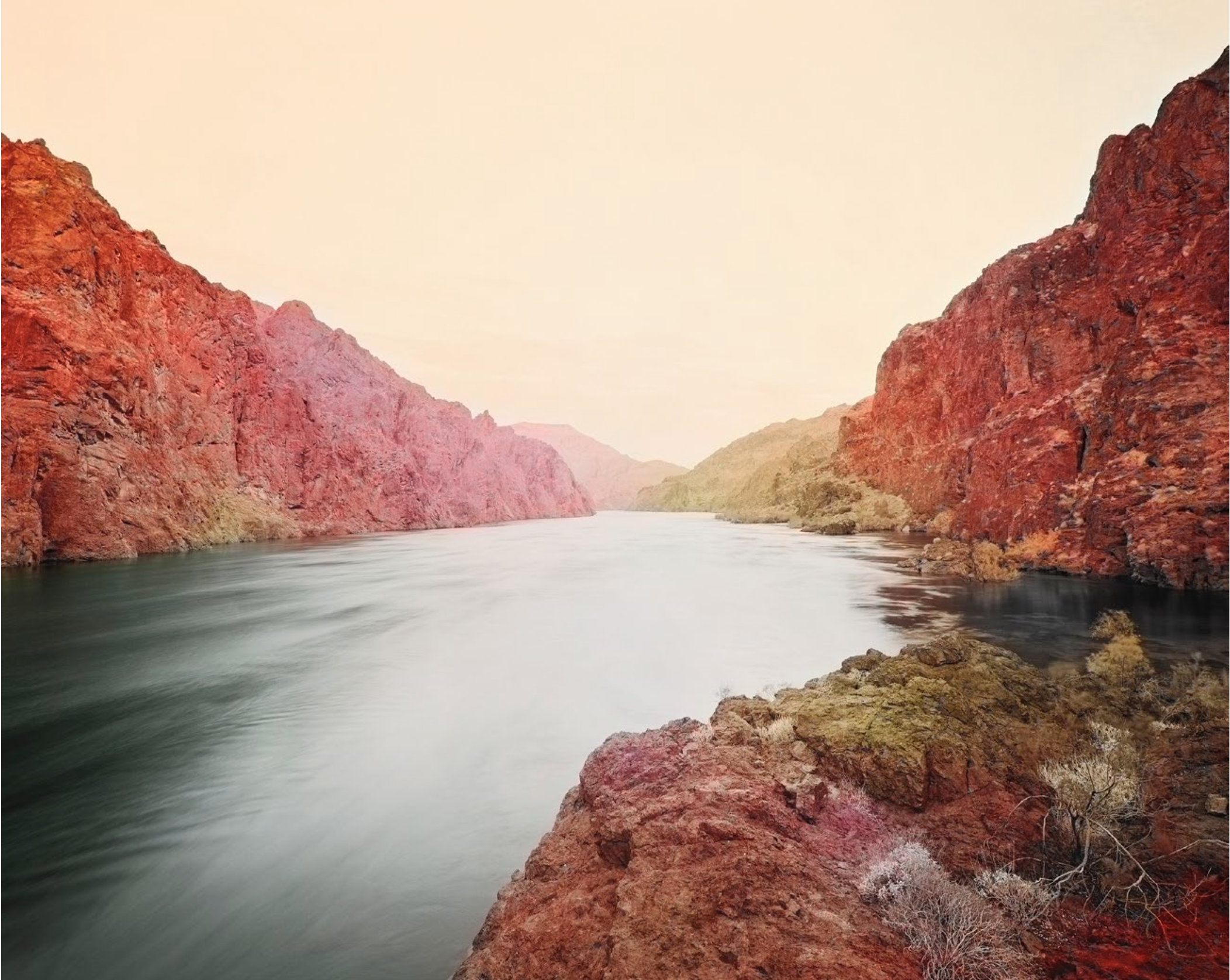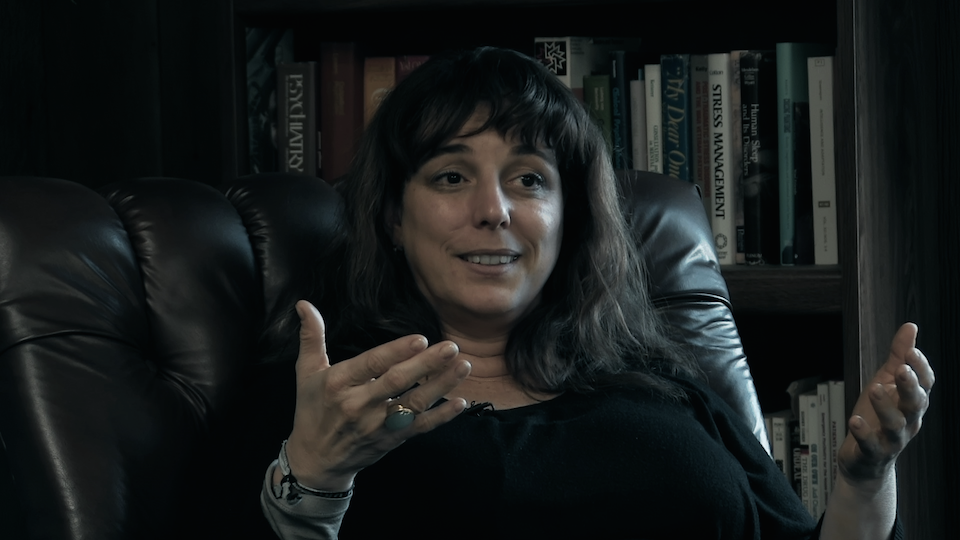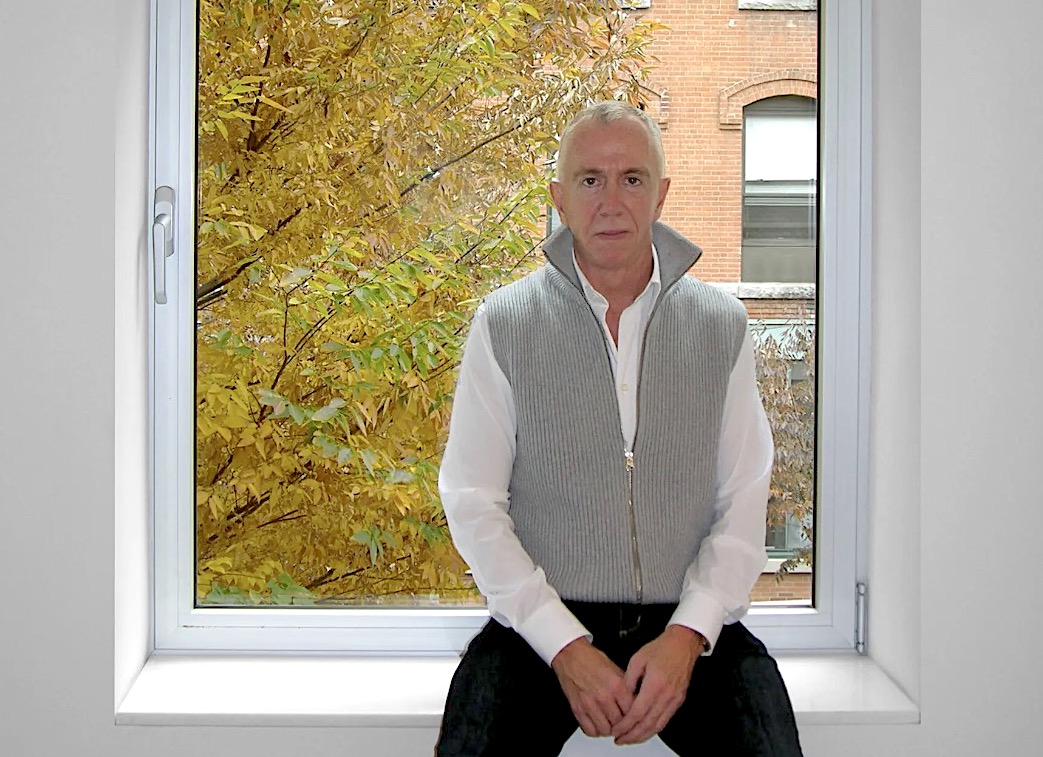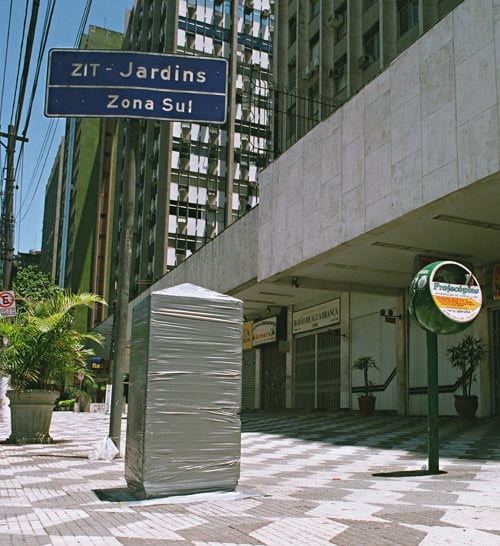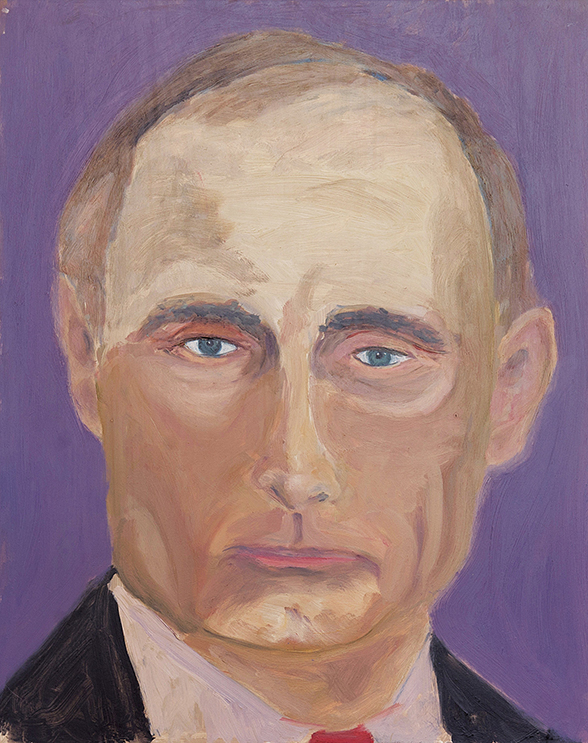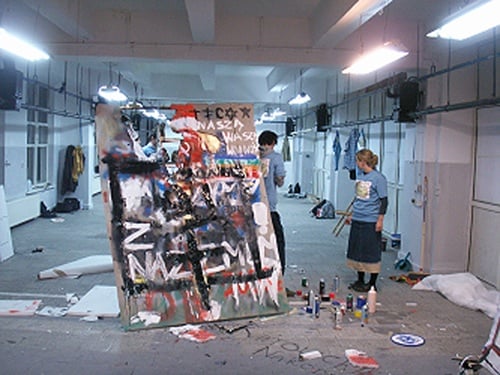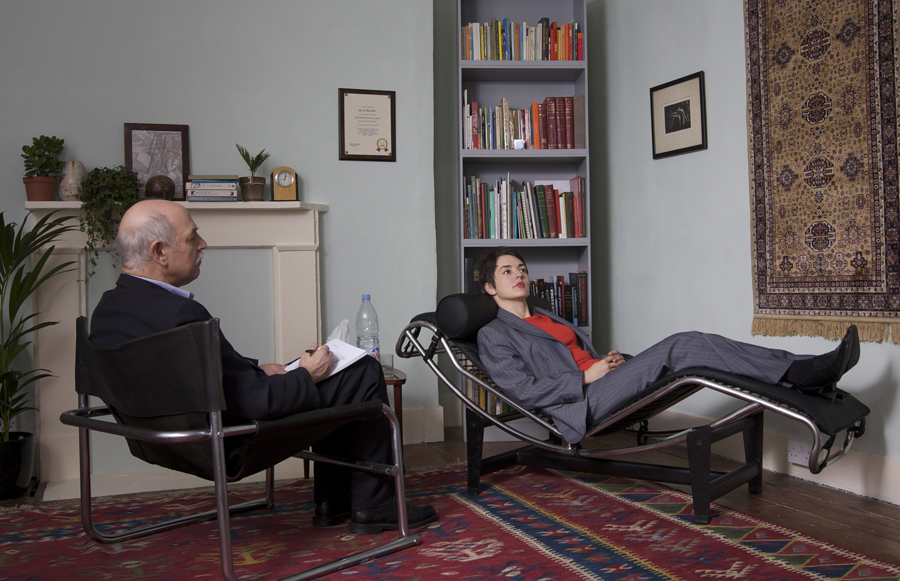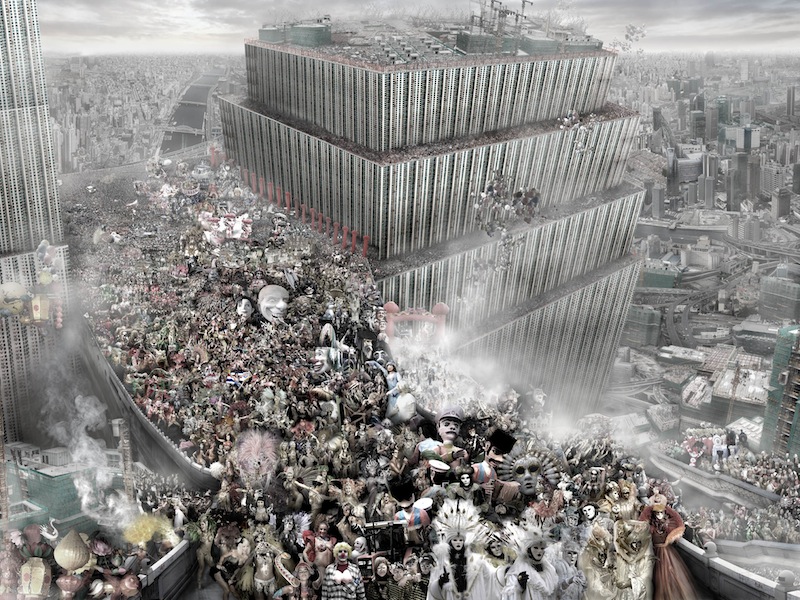
© » KADIST
Egle Jauncems
The title of this work by Egle Jauncems, The Paler King I , is taken from an unfinished novel by the late David Foster Wallace called The Pale King, published posthumously in 2015. Jauncems notes that the book is fragmented, following unrelated characters struggling with ennui and depression, navigating the pressures of modern reality. In her art practice, Jauncems has been interested in the lives of powerful and influential men for many years.

© » KADIST
Prabhakar Kamble
To produce the series of sculptures collectively titled Utarand , Prabhakar Kamble relocated his studio to Kolhapur, Maharashtra, near the village where he was born into a family of daily wage earners. Kamble cast the feet of agricultural workers in metal to prop up the eponymous terracotta pots traditionally used to store food and grains in every home. A commentary on the caste system’s four-tiered hierarchy, the pots become smaller as they go up the stand, mimicking the structure of society where most of the population is comprised of impoverished communities, which form the base of the caste system while a small minority makes up the wealthy upper castes.

© » KADIST
Nikita Kadan
Drawing & Print (Drawing & Print)
Ukraine is under tension due to the politics of President lanoukovitch since 2010. Numerous passive demonstrations against the government have led to numerous police repression of the protestors. The demonstration ‘Euromaïdan’ in 2013 is a perfect example.

© » KADIST
Ghita Skali
The Hole’s Journey by Ghita Skali follows a complex political satire involving a worn-out floor, a political activist, and the Ouled Sbita tribe of Morocco. For 23 years, the director’s chair at an international art institute in the Netherland’s scratched the wooden floor below it. For Skali’s project, a 102 cm x 120 cm section of this scratched floor was cut out and mailed to an expropriated region in Morocco.

© » KADIST
Maayan Amir and Ruti Sela
In Beyond Guilt the two artists create a portrait of our generation in three parts. In Tel Aviv, in confined spaces such as toilets or bar of hotel rooms, they create situations in which participants answer questions and describe themselves. Camera in hand, there is little editing in their works, leaving a rather crude result.

© » KADIST
James "Yaya" Hough
Drawing & Print (Drawing & Print)
This untitled ink and pencil drawing by James “Yaya” Hough is made on what the artist calls “institutional paper”, or the state-issued forms that monitor the daily activities of prisoners, of which, each detainee is generally required to fill out in triplicate. This drawing uses a pink form on which an inmate can list telephone contacts for approval. The drawing depicts two uniformed figures, with backwards feet, berating a figure on a toilet.

© » KADIST
Pu Yingwei
ChinaCapital: Dream, Hot Land, Interstellar Colonization by Pu Yingwei addresses a complicated phenomena of intertwined influences from different political powers, capital forces, and ideologies in the reality of China. The background of this painting is taken from an image of a Russian stamp featuring a space odyssey during the Cold War with the US. The composition juxtaposes colors from the Chinese national flag (red and yellow) and the US national flag (blue and red), echoing the current “cold war” between China and the U. S. Usually found surrounding a big star on the Chinese national flag, the 4 stars are here rearranged into a single line, symbolizing the artist’s wish for a decentralised and equal society.

© » KADIST
Sandra Monterroso
Sandra Monterroso’s video performance titled Corazón del lugar del viento (Heart of the Place of the Wind) is inspired by Seis Cielo (Six Sky), the only female Mayan ruler to be represented in classical Mayan stelae (historical monuments dedicated to the record of important events). As the artist impersonates the ruler and goddess, she performs a ritual of tying stones and an offering of clothing. Seis Cielo’s ties with the lineages of the prehispanic Tikal and Dos Pilas kingdoms were essential in understanding the role of Mayan women as mothers and wives, and especially as rulers and healers.
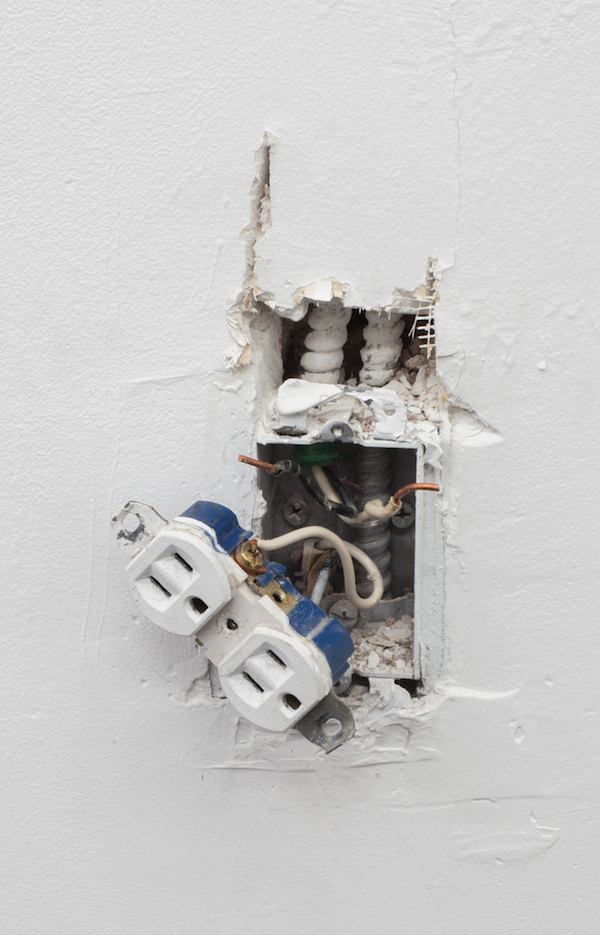
© » KADIST
Cameron Rowland
Rowland’s minimal installations require a focus not on the objects themselves, but on the conditions of their creation, use, and distribution. Who controls the services that contemporary citizens take for granted—like power, water, heat? Who makes these objects that deliver these services?

© » KADIST
Sawangwongse Yawnghwe
22022021, Yawnghwe Office in Exile by Sawangwongse Yawnghwe belongs to a body of work made in response to the Myanmar military coup that began in February 2021. The work employs traditional Burmese textiles, which have been employed by protesters harnessing the power of old Myanmar lore. It is said that women’s bodies and the garments that cover them sap men of their power.

© » KADIST
Nikita Kadan
Drawing & Print (Drawing & Print)
Ukraine is under tension due to the politics of President lanoukovitch since 2010. Numerous passive demonstrations against the government have led to numerous police repression of the protestors. The demonstration ‘Euromaïdan’ in 2013 is a perfect example.

© » KADIST
Paolo Cirio
Capture is a photographic series by Paolo Cirio in which the artist sourced 1000 public images of police officers’ faces and processed them with facial recognition technology. The original photographs were taken during protests in France, Cirio collected these images and created an online platform containing a database of the 4000 police faces that the AI program isolated. The artist crowdsourced their identification by name and then publicly exposed the officers by printing their headshots and posting them throughout Paris.

© » KADIST
Bady Dalloul
Drawing & Print (Drawing & Print)
geopoliticalThe Great Game is a series of works composed of a number of card combinations illustrated by the faces of key political figures shaping the geopolitical landscape in the Middle East. Each reconstituted ‘hand of play’ corresponds to a diplomatic treaty establishing or modifying geographical borders. The plastic form of a poker hand chosen by the artist highlights the randomness of the process of fixing boundaries and the way in which they do not account for the lives of those located there.

© » KADIST
Bruno Zhu
Mr. Black, Mr. Navy, Mr. Stripes is a photographic series of opera gloves made of men’s tailored trousers that were presented in 2017 in “La Plage” in Paris, a shop window turned into an experimental art space. The personification of the objects named after characters intended to compose a fiction from the display. The project follows Zhu’s thinking on the definition of “queer”: how to express a state?

© » KADIST
Aung Ko
They burn our village by Aung Ko is part of the artist’s daily visual diary as an attempt to process and note what has been happening in Myanmar while he is being exiled, following the military takeover of the government in February 2021. Almost two years ago, Myanmar’s military ousted the democratically elected government of Aung San Suu Kyi and seized power in a coup. Since then, the country has descended into turmoil.

© » KADIST
James "Yaya" Hough
Drawing & Print (Drawing & Print)
This untitled ink and pencil drawing by James “Yaya” Hough is made on what the artist calls “institutional paper”, or the state-issued forms that monitor the daily activities of prisoners, of which, each detainee is generally required to fill out in triplicate. The form used for this drawing is a request for medical attention. This work illustrates an assembly-line of severed bodies being pumped full of feet and other body parts.

© » KADIST
Uche Okpa-Iroha
In the fictional narrative Plantation Boy (2012), Irhoa places himself inside imagery from Francis Ford Coppola’s seminal The Godfather (1972). Inflected with humor, the series examines race in society. According to the artist, the 40 images collectively question structures of power and the hegemony of Western culture.

© » KADIST
James "Yaya" Hough
Drawing & Print (Drawing & Print)
This untitled ink and pencil drawing by James “Yaya” Hough is made on what the artist calls “institutional paper”, or the state-issued forms that monitor the daily activities of prisoners, of which, each detainee is generally required to fill out in triplicate. The form used for this drawing details a weekly menu for the prisoners. Hough’s drawing depicts three grimacing figures, riding atop the back of a larger, female figure on all fours.
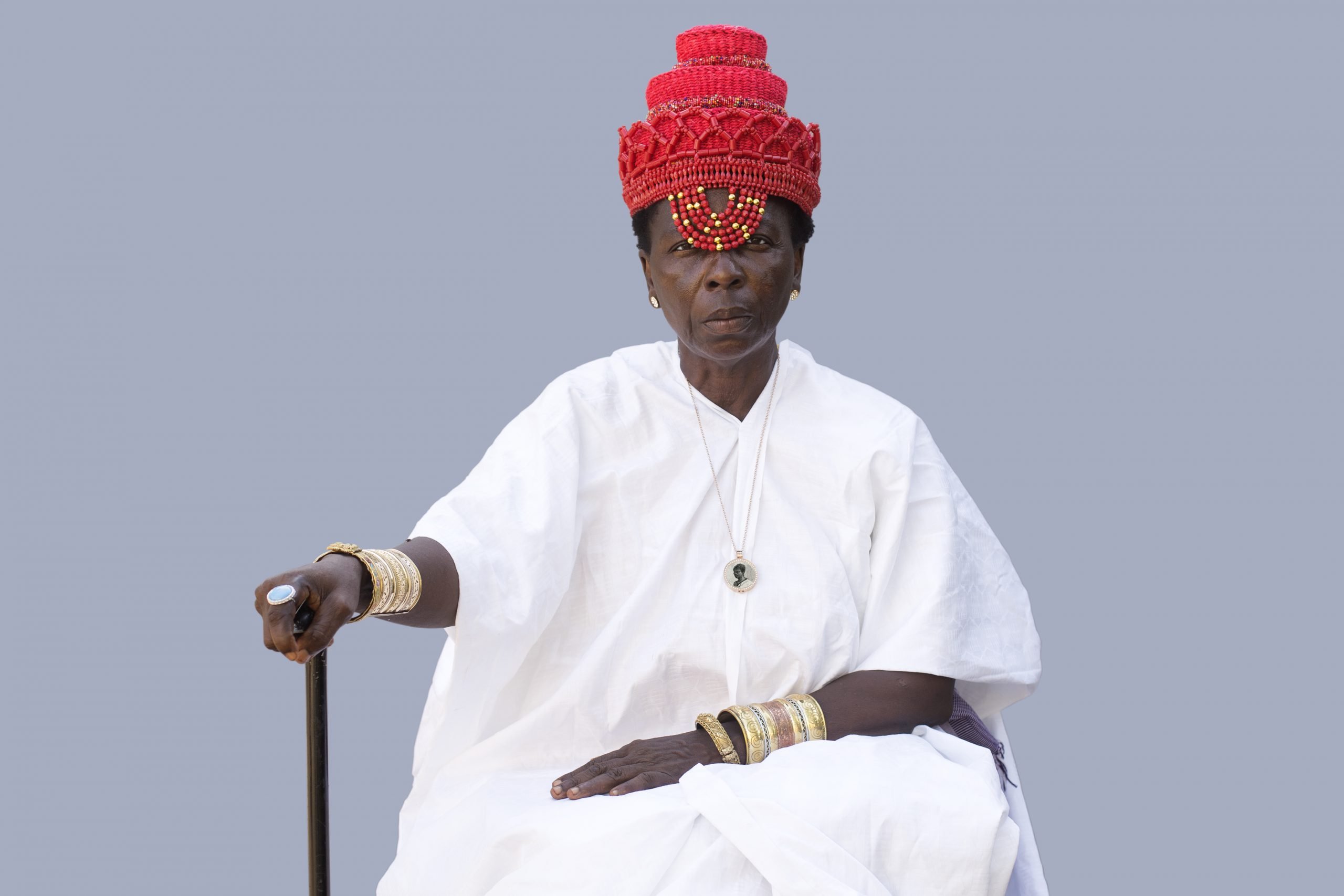
© » KADIST
Ishola Akpo
Noticing the lack of archives on the queens of various African kingdoms, artist Ishola Akpo created several series of work that retrace their history. Akpo uses different mediums in these projects, as a metaphor to the complex stories of the figures and their true political weight. One part of the project, the Agbara Women photographic series, employs fictional portraits that sheds light on the queens’ histories.

© » KADIST
Jumana Manna
Blue Elbow (Coude bleu) is made from plaster, burlap, lacquer, pigments and plastics. The materials related to the techniques of the sculpture or the painting but also others, which refer to commerce, to objects of consumption. The chair refers directly to the body as does the title of the work, Blue Elbow .

© » KADIST
Nikita Kadan
Drawing & Print (Drawing & Print)
East of Ukraine became a place of armed conflict with Russia-backed separatists, who proclaimed parts of (the) Donetsk and Lughansk oblast (administrative region in Ukrainian) to be ‘People’s republics’. This region, in conflict since spring 2014, is where most of the charcoal is extracted. It is with this same coal that artist Nikita Kadan realizes this drawing in 2018, representing a field on which is juxtaposed a small photograph.

© » KADIST
Bani Abidi
The perceived effortlessness of power, projecting above experiences of labored subordination is examined in Death at a 30 Degree Angle by Bani Abidi, which funnels this projection of image through the studio of Ram Sutar, renowned in India for his monumental statues of political figures, generally from the post-independence generation. In a contemporary Indian society beholden by strongmen, Abidi uses Sutar’s studio to fictionalize a sculptor producing commemorative works for populist, preening figures, surrounded by the likenesses of idolized politicians of the post-colony. Abidi’s video presents one such aspirational bureaucrat, trailed by a cadre of lackeys who fawn over the varying statues that are laboriously carted out for his approval.

© » KADIST
Minerva Cuevas
Drawing & Print (Drawing & Print)
During her research on primitive currencies and cultural cannibalism, Cuevas came across the Donald Duck comic book issue “The Stone Money Mystery,” where Donald goes on a quest to find missing museum objects. Cuevas’s America (2006) is a wall painting of a comic Donald Duck wallowing in a heap of gold coins, alluding to Mexico’s postrevolutionary mural tradition. The mural’s background is one of the earliest illustrations of flora and fauna in the American continent, juxtaposed with a reference to America as having bountiful natural resources available to be exploited, and the historical use of comics as ideological tools.

© » KADIST
Jesse Krimes
Raybrook by Jesse Krimes takes its name from The Federal Correctional Institution, Ray Brook (FCI Ray Brook), a medium-security United States federal prison for male inmates located in Essex County, NY. In addition to its indexical title, this quilt-work tapestry is made from personal clothing and other like articles the artist was given by currently, and formerly incarcerated persons. It is part of a larger series of works called the Elegy Quilts , which illustrate domestic scenes inspired by conversations the artist has had with the individuals these fabrics were acquired from.

© » KADIST
Runo Lagomarsino
Drawing & Print (Drawing & Print)
On Fire by Runo Lagomarsino comprises twenty pieces of parchment, each of which has had the contours and map of Brazil burned in stages. The work’s connection to Amazon deforestation is difficult to ignore. Yet still, it also engages in broader issues about the country’s fractures, such as the 2018 fire at Rio de Janeiro’s National Museum and the ongoing erasure of its past.

© » KADIST
Jeff Burton
In Eniko Mihalik (2012), the camera captures a glimpse of the eponymous Hungarian model as seen through a rearview mirror. They are both two examples of the artist’s many enigmatic photographs of models, actors, musicians, and other powerful figures rooted in the celebrity-driven culture of Los Angeles. Catching a glimpse of the model, the viewer enters into the world of the celebrity.

© » KADIST
Claudia Joskowicz
Some Dead Don’t Make a Sound (Hay muertos que no hacen ruido) is a single-channel video by Claudia Joskowicz that features the Mexican legend of the Weeping Woman (La Llorona) as its main protagonist. The video begins with the image of a ghost-like female figure, representing La Llorona, slowly walking down a well-known street in Oaxaca, from the main square (el Zócalo) to the Teatro Macedonio Alcalá, with a painful expression on her face. According to this famous oral myth, the Weeping Woman drowned her two sons in a fit of grief and anger after her husband abandoned her.

© » KADIST
Trevor Paglen
Half Dome Hough Transform by Trevor Paglen merges traditional American landscape photography (sometimes referred as ‘frontier photography’ for sites located in the American West) with artificial intelligence and other technological advances such as computer vision. This photograph was taken at Half Dome, a frequently visited granite rock formation in Yosemite National Park, California. For this work, Paglen created a digital file of the 8 x 10 inch photographic negative so that the artificial intelligence program can apply computer vision to evaluate the content of the image.
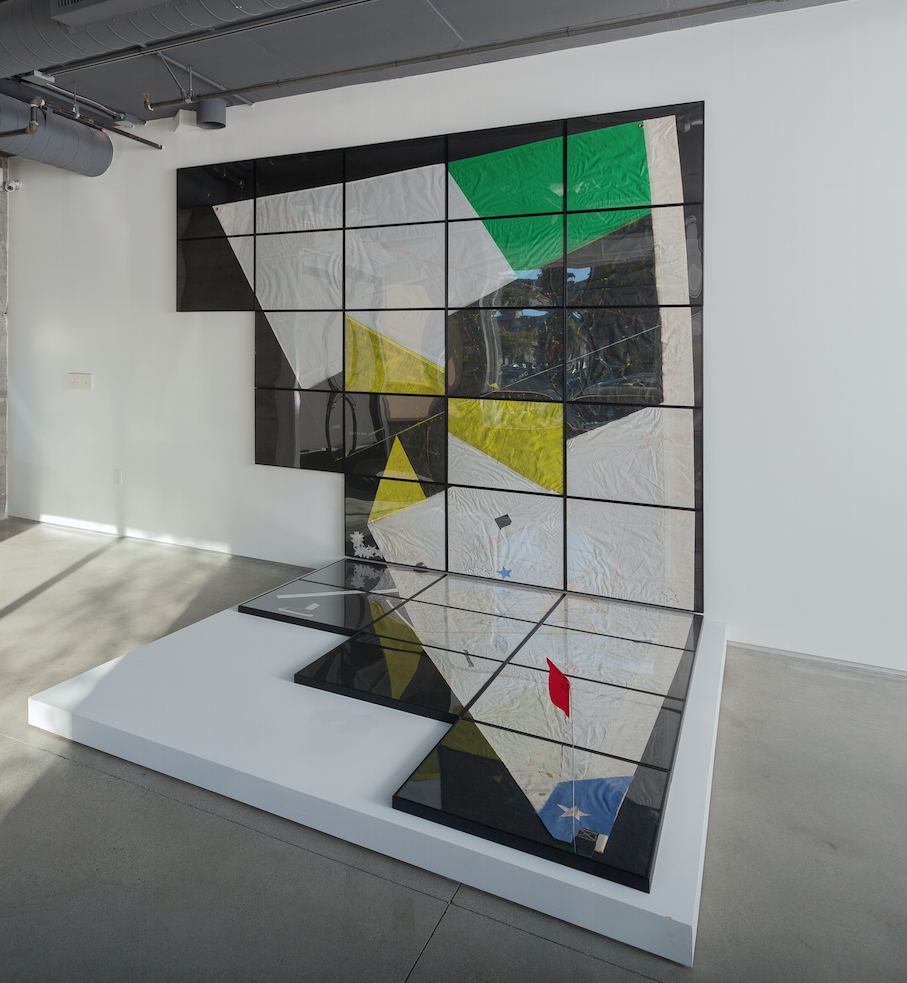
© » KADIST
Enrique Ramirez
Ramirez’s The International Sail is the fifth in a series that features an upside-down worn out, mended and fragmented boat sail. These works epitomize the idea of perpetual movement and migration while carrying a deep personal meaning in the creative process, as the artist’s father himself, still living in Chile, mends and sends the sails to his son, living in Europe. The reversed position of the sail recalls both the shape of South America itself and the Eurocentric view that in the Southern Hemisphere, everything is “upside-down.” The stitches themselves create an illusion of an alternative political geography, and the framed-cuts impose a cartographic grid.
Sawangwongse Yawnghwe
Sawangwongse Yawnghwe comes from the Yawnghwe royal family of Shan...
Trevor Paglen
Trevor Paglen’s work combines the knowledge-base of artist, geographer and activist...
James "Yaya" Hough
Working in ballpoint pen, pencil, and watercolor, often on the backs of bureaucratic prison forms, James “Yaya” Hough’s work conveys the burdens of incarcerated life, revealing not only the brutal reach of the carceral system, but laying bare its affects...
Nikita Kadan
Trained in large-scale painting, Nikita Kadan’s artistic practice encompasses installation, graphics, painting, wall drawing, and urban postering, sometimes in collaboration with architects, human rights activists, and sociologists...
Chantal Edie and Zacharie Ngnogue
Chantal Edie and Zacharie Ngnogue are a photography duo who channel their personal experiences into social commentaries...
Paolo Cirio
Artist Paolo Cirio engages with legal, economic, and cultural systems of information...
Prabhakar Kamble
Prabhakar Kamble is an artist, curator, and cultural activist...
Claudia Joskowicz
Claudia Joskowicz is a video and installation artist working at the intersection of landscape, history, and memory...
Lynn Hershman Leeson
- location: San Francisco, California
- year born: 1941
- gender: female
- nationality: American
- home town: Cleveland, Ohio
Du Zhenjun
- location: Paris, France
- location: Shanghai, China
- year born: 1961
- gender: male
- nationality: Chinese
- home town: Shanghai, China
Bady Dalloul
Bady Dalloul cunningly employs collage across various media: texts, drawings, video, and objects to produce powerful works commenting on the past and the present...
Pedro Reyes
- location: Mexico City, Mexico
- year born: 1972
- gender: male
- nationality: Mexican
- home town: Mexico City, Mexico
Yee I-Lann
- location: Kuala Lumpur, Malaysia
- year born: 1971
- gender: female
- nationality: Malaysian
- home town: Sabah, Malaysia
Tan Zi Hao
Tan Zi Hao is a multi-disciplinary artist who works predominantly with installation and performance art...
Maayan Amir and Ruti Sela
Maayan Amir and Ruti Sela, two young Israeli women artists work collaboratively or individually by project...
Louisa Bufardeci
Louisa Bufardeci is fascinated by the way our world is visually materialized through data measurement...
Yao Qingmei
Informed by her long-term interest in the complex tensions between music, dance, text, and video, Yao Qingmei’s practice collapses the boundary between performance and its site...
Ghita Skali
Ghita Skali is a visual artist that uses odd news, rumors and propaganda to disrupt institutional power structures such as the western contemporary art world, state oppression and government politics...
Bani Abidi
Bani Abidi’s practice deals heavily with political and cultural relations between India and Pakistan; she has a personal interest in this, as she lives and works in both New Delhi and Karachi...
Apostolos Georgiou
Inescapably political, Apostolos Georgiou’s paintings are realized by bold and mastered brush strokes...
Ishola Akpo
Ishola Akpo is a photographer and multimedia artist whose practice explores the possibilities of digital technology...
Minerva Cuevas
- location: Mexico City, Mexico
- year born: 1975
- gender: female
- nationality: Mexican
- home town: Mexico City, Mexico
Risham Syed
Risham Syed has a diverse art practice in which painting and other mediums are used to explore issues of history, sociology, and politics...
Tony Cokes
Since the 1990s, Tony Cokes’s video works generate complex layers of meaning through the juxtaposition of basic elements such as language and sound...
Erbossyn Meldibekov
Through drawing, installation, painting, photography, and video, Erbossyn Meldibekov’s practice examines architecture, monumentality, and value systems in the public domain...
Kara Walker
- location: New York, New York
- year born: 1969
- gender: female
- nationality: American
- home town: Stockton, California
Carey Young
- location: Lusaka, Zambia
- year born: 1970
- gender: female
- nationality: Zambian
Runo Lagomarsino
- location: Malmo, Sweden
- location: Sao Paolo, Brazil
- year born: 1977
- gender: male
- nationality: Italian-Argentine-Swedish
- home town: Sweden
Egle Jauncems
Egle Jauncems’s practice considers the relationship between painting and textile art...
-
2000-2009
Maayan Amir and Ruti Sela
2003In Beyond Guilt the two artists create a portrait of our generation in three parts...
Mikhael Subotzky
2004“Pasvang, Pollsmoor Maximum Security Prison” is the result of three months Subotzky spent inside the walls of Pollsmoor Prison, an overcrowded correctional facility largely controlled by gangs...
Kara Walker
2005In her masterpiece 8 Possible Beginnings or The Creation of African-America , Walker unravels just that, the story of struggle, oppression, escape and the complexities of power dynamics in the history following slave trade in America...
Minerva Cuevas
Drawing & Print
2006(Drawing & Print) During her research on primitive currencies and cultural cannibalism, Cuevas came across the Donald Duck comic book issue “The Stone Money Mystery,” where Donald goes on a quest to find missing museum objects...
Clare Rojas
2006Rojas’s two pieces in the Kadist Collection— Untitled (four-legged…) and Untitled (Bird’s Eyes) —are representative of her pictorial style which uses bold colorful blocks of paint and female and animal characters...
Kwan Sheung Chi
2007A Flags-Raising-Lowering Ceremony at my home’s cloths drying rack (2007) was realized in the year of the 10th anniversary of the establishment of The Hong Kong Special Administrative Region of the People’s Republic of China...
Carey Young
2007“Product Recall” is a video perfomative pun on the action recalling memories in the form of a psychoanalytic session and the recall of faulty products from multinational corporations...
Lynn Hershman Leeson
2007Lynn Hershman Leeson’s genre-bending documentary Strange Culture tells the story of how one man’s personal tragedy turns into persecution by a paranoid, conservative, and overzealous government...
Thomas Kilpper
Drawing & Print
2009(Drawing & Print) These two images come from the series called “State of Control” which Kilpper made in the building formerly occupied by the Stasi in Berlin...
Mahmoud Khaled
2009CAMARADERIE is a precursor to and a blueprint for Mahmoud Khaled’s later forays into queer aesthetics and modes of visual representation...
-
2010-2019
Du Zhenjun
2010The Tower of Babel is an installation of large-format photographs that forces the audience to occupy a central position through its monumental scale...
Marcelo Cidade
2010Marcelo Cidade’s sculpture Abuso de poder (Abuse of Power, 2010) is a mousetrap elegantly crafted in Carrara marble...
Du Zhenjun
2010The Tower of Babel is an installation of large-format photographs that forces the audience to occupy a central position through its monumental scale...
Adelita Husni-Bey
2011Postcards from the Desert Island is a remake of a 50s educational film Holiday from the rules in which four children interact with an omniscient narrator who teleports them to a tropical island where there are no rules...
Uche Okpa-Iroha
2012In the fictional narrative Plantation Boy (2012), Irhoa places himself inside imagery from Francis Ford Coppola’s seminal The Godfather (1972)...
Jeff Burton
2012In Eniko Mihalik (2012), the camera captures a glimpse of the eponymous Hungarian model as seen through a rearview mirror...
Bani Abidi
2012The perceived effortlessness of power, projecting above experiences of labored subordination is examined in Death at a 30 Degree Angle by Bani Abidi, which funnels this projection of image through the studio of Ram Sutar, renowned in India for his monumental statues of political figures, generally from the post-independence generation...
Nikita Kadan
Drawing & Print
2013(Drawing & Print) Ukraine is under tension due to the politics of President lanoukovitch since 2010...
Nikita Kadan
Drawing & Print
2013(Drawing & Print) Ukraine is under tension due to the politics of President lanoukovitch since 2010...
Yee I-Lann
2013Sarcastically titled to call attention to the problematic notions underlying colonialism, this photograph shows hundreds of Native Malaysians seated quietly behind one of their colonial oppressors...
Tan Zi Hao
2013Tan Zi Hao produced Pest Control 1110, 709, 428 (or, a Myth for Another) , in response to the Bersih social movement, that catalyzed three rallies on 10th November 2007, 9th July 2011 and 28th April 2012, respectively, to demand a clean electoral roll...
Carolina Caycedo
2013In this two-channel video installation, Spaniards Named Her Magdalena, But Natives Called Her Yuma , Carolina Caycedo gathered footage during numerous research trips to dam sites in the Harz Mountains, Saxony, Westphalia and the Black Forest in Germany interspersed with images of the Rio Magdalena region in Colombia...
Cameron Rowland
2014Rowland’s minimal installations require a focus not on the objects themselves, but on the conditions of their creation, use, and distribution...
Maya Watanabe
2014In Escenarios (Sceneries) Maya Watanabe films forgotten wastelands through a series of 360° camera movements that highlight the dramatism and visual richness of terrain that would be otherwise forgotten...
Claudia Joskowicz
2014Los rastreadores is a two-channel video by Claudia Joskowicz narrating the story of a fictitious drug lord, Ernesto Suarez, whose character is based on the well-known Bolivian drug dealer, Roberto Suárez...
Jumana Manna
2015Blue Elbow (Coude bleu) is made from plaster, burlap, lacquer, pigments and plastics...
Claudia Joskowicz
2015Some Dead Don’t Make a Sound (Hay muertos que no hacen ruido) is a single-channel video by Claudia Joskowicz that features the Mexican legend of the Weeping Woman (La Llorona) as its main protagonist...
Naufus Ramírez-Figueroa
2015Naufus Ramírez-Figueroa’s performance Illusion of Matter establishes a dream state through a composition of motifs that were drawn from the artist’s childhood memories...
Sarah Lai Cheuk Wah
2015Back images is a series of six photographs by Sarah Lei Cheuk Wah that explore the semiotics of power and their intersection with representations of masculinity...
Adriana Martínez
2015Her 2015 work Orión is a black flag-like cloth with glow-in-the-dark symbols embroidered in the shape of the constellation...
James "Yaya" Hough
Drawing & Print
2016(Drawing & Print) This untitled ink and pencil drawing by James “Yaya” Hough is made on what the artist calls “institutional paper”, or the state-issued forms that monitor the daily activities of prisoners, of which, each detainee is generally required to fill out in triplicate...
James "Yaya" Hough
Drawing & Print
2016(Drawing & Print) This untitled ink and pencil drawing by James “Yaya” Hough is made on what the artist calls “institutional paper”, or the state-issued forms that monitor the daily activities of prisoners, of which, each detainee is generally required to fill out in triplicate...
James "Yaya" Hough
Drawing & Print
2016(Drawing & Print) This untitled ink and pencil drawing by James “Yaya” Hough is made on what the artist calls “institutional paper”, or the state-issued forms that monitor the daily activities of prisoners, of which, each detainee is generally required to fill out in triplicate...
Bady Dalloul
Drawing & Print
2017(Drawing & Print) geopoliticalThe Great Game is a series of works composed of a number of card combinations illustrated by the faces of key political figures shaping the geopolitical landscape in the Middle East...
Enrique Ramirez
2017Ramirez’s The International Sail is the fifth in a series that features an upside-down worn out, mended and fragmented boat sail...
Erbossyn Meldibekov
2017Game (Six Pieces) by Erbossyn Meldibekov is inspired by the popular Rubik’s cube puzzle and is composed of three colors (red, green and white) instead of six, referencing the colors of the Afghan flag...
Trevor Paglen
2017Trevor Paglen’s ongoing research focuses on artificial intelligence and machine vision, i.e...
Jessie Stead
2017Jessie Stead’s Punched Interlude works are made out of found police barricade tape that she punches holes in and then runs through a music box, the music is composed by her as audible reflection on barricades and no go zones throughout the city of New York in area of Donald Trump...
Doreen Lynette Garner
2017Known But to God: The Dug Up, Dissected, and Disposed for the Sake of Medicine by Doreen Lynnette Garner is a small, suspended sculpture composed of glass, silicone, steel, epoxy putty, pearls, Swarovski crystals, and whiskey...
Karan Shrestha
2017After the decade-long conflict (1996-2006) that ended with Nepal becoming a Federal Democratic Republic, political unrest and weak governance continued to mark the country’s future as daily life repeatedly witnessed ruptures...
Bady Dalloul
Drawing & Print
2017(Drawing & Print) The Great Game is a series of works composed of a number of card combinations illustrated by the faces of key political figures shaping the geopolitical landscape in the Middle East...
Lynn Hershman Leeson
2017Using the seminal 1958 film Vertigo as a launchpad, Lynn Hershman Leeson explores the blurred lines between fact and fantasy in VertiGhost , a film commissioned by the Fine Arts Museums in San Francisco...
Yao Qingmei
2017Satirizing an airport security checkpoint, The Ecdysiast – Molt (Body Inspection) by Yao Qingmei offers a comedic and critical inquiry into the logics underpinning collective control and surveillance culture...
Nikita Kadan
Drawing & Print
2018(Drawing & Print) East of Ukraine became a place of armed conflict with Russia-backed separatists, who proclaimed parts of (the) Donetsk and Lughansk oblast (administrative region in Ukrainian) to be ‘People’s republics’...
Egle Jauncems
2019The title of this work by Egle Jauncems, The Paler King I , is taken from an unfinished novel by the late David Foster Wallace called The Pale King, published posthumously in 2015...
Diego Bianchi
2019Diego Bianchi’s main concern is distorting straight lines, both literally and metaphorically...
Matt Kane
Advanced Technology
2019(Advanced Technology) Matt Kane initiated the project Right Place & Right Time – Bitcoin Volatility Art in 2019...
-
2020-2029
Runo Lagomarsino
Drawing & Print
2020(Drawing & Print) On Fire by Runo Lagomarsino comprises twenty pieces of parchment, each of which has had the contours and map of Brazil burned in stages...
Paolo Cirio
2020Capture is a photographic series by Paolo Cirio in which the artist sourced 1000 public images of police officers’ faces and processed them with facial recognition technology...
Trevor Paglen
2020Half Dome Hough Transform by Trevor Paglen merges traditional American landscape photography (sometimes referred as ‘frontier photography’ for sites located in the American West) with artificial intelligence and other technological advances such as computer vision...
Ghita Skali
2020The Hole’s Journey by Ghita Skali follows a complex political satire involving a worn-out floor, a political activist, and the Ouled Sbita tribe of Morocco...
Pu Yingwei
2020ChinaCapital: Dream, Hot Land, Interstellar Colonization by Pu Yingwei addresses a complicated phenomena of intertwined influences from different political powers, capital forces, and ideologies in the reality of China...
Jesse Krimes
2020Raybrook by Jesse Krimes takes its name from The Federal Correctional Institution, Ray Brook (FCI Ray Brook), a medium-security United States federal prison for male inmates located in Essex County, NY...
Chantal Edie and Zacharie Ngnogue
2020Au non de la liberté (Tiko drink Kumba drunk) is a photographic series by Zacharie Ngnogue and Chantal Edie that considers the correlation between those who hold power in Cameroon and how their actions affect the populations they rule in often compromising ways...
Paolo Cirio
2020Capture is a photographic series by Paolo Cirio in which the artist sourced 1000 public images of police officers’ faces and processed them with facial recognition technology...
Chantal Edie and Zacharie Ngnogue
2020Au non de la liberté (Tiko drink Kumba drunk) is a photographic series by Zacharie Ngnogue and Chantal Edie that considers the correlation between those who hold power in Cameroon and how their actions affect the populations they rule in often compromising ways...
Chantal Edie and Zacharie Ngnogue
2020Au non de la liberté (Tiko drink Kumba drunk) is a photographic series by Zacharie Ngnogue and Chantal Edie that considers the correlation between those who hold power in Cameroon and how their actions affect the populations they rule in often compromising ways...
Trevor Paglen
2020The Black Canyon Deep Semantic Image Segments by Trevor Paglen merges traditional American landscape photography (sometimes referred as ‘frontier photography’ for sites located in the American West) with artificial intelligence and other technological advances such as computer vision...
Edgardo Aragón
2020In the agricultural areas of Mexico, Indigenous people use the mylar magnetic tape unspooled from VHS cassettes as an alternative to the scarecrow—the reflective tape flutters in the wind and does an excellent job scaring birds away from crops...
Paolo Cirio
2020Capture is a photographic series by Paolo Cirio in which the artist sourced 1000 public images of police officers’ faces and processed them with facial recognition technology...
YOUNG-HAE CHANG HEAVY INDUSTRIES
2020The absurd condition of human survival under environmental degradation and geonational balkanization is taken as a starting point for WA’AD by YOUNG-HAE CHANG HEAVY INDUSTRIES...
Ishola Akpo
2021Noticing the lack of archives on the queens of various African kingdoms, artist Ishola Akpo created several series of work that retrace their history...
Sawangwongse Yawnghwe
202122022021, Yawnghwe Office in Exile by Sawangwongse Yawnghwe belongs to a body of work made in response to the Myanmar military coup that began in February 2021...
Sawangwongse Yawnghwe
202122022021, Yawnghwe Office in Exile by Sawangwongse Yawnghwe belongs to a body of work made in response to the Myanmar military coup that began in February 2021...
Sawangwongse Yawnghwe
202122022021, Yawnghwe Office in Exile by Sawangwongse Yawnghwe belongs to a body of work made in response to the Myanmar military coup that began in February 2021...
Sawangwongse Yawnghwe
202122022021, Yawnghwe Office in Exile by Sawangwongse Yawnghwe belongs to a body of work made in response to the Myanmar military coup that began in February 2021...
Sawangwongse Yawnghwe
202122022021, Yawnghwe Office in Exile by Sawangwongse Yawnghwe belongs to a body of work made in response to the Myanmar military coup that began in February 2021...
Sawangwongse Yawnghwe
202122022021, Yawnghwe Office in Exile by Sawangwongse Yawnghwe belongs to a body of work made in response to the Myanmar military coup that began in February 2021...
Prabhakar Kamble
2022To produce the series of sculptures collectively titled Utarand , Prabhakar Kamble relocated his studio to Kolhapur, Maharashtra, near the village where he was born into a family of daily wage earners...
Sandra Monterroso
2022Sandra Monterroso’s video performance titled Corazón del lugar del viento (Heart of the Place of the Wind) is inspired by Seis Cielo (Six Sky), the only female Mayan ruler to be represented in classical Mayan stelae (historical monuments dedicated to the record of important events)...
Prabhakar Kamble
2022To produce the series of sculptures collectively titled Utarand , Prabhakar Kamble relocated his studio to Kolhapur, Maharashtra, near the village where he was born into a family of daily wage earners...
Tony Cokes
2022Tony Cokes’s long-form, multi-channel work Some Munich Moments 1937–1972 forms a layered montage of historical and contemporary source material exploring different periods of Munich’s history...
Risham Syed
2022Risham Syed discovered a box of woven Chinese silk panels that was her mother’s most prized possession...
Prabhakar Kamble
2022To produce the series of sculptures collectively titled Utarand , Prabhakar Kamble relocated his studio to Kolhapur, Maharashtra, near the village where he was born into a family of daily wage earners...


